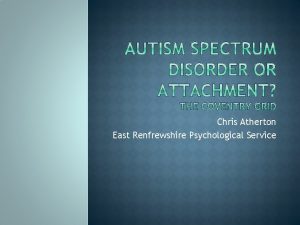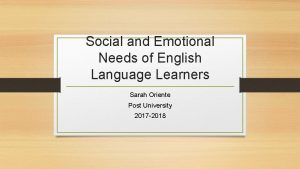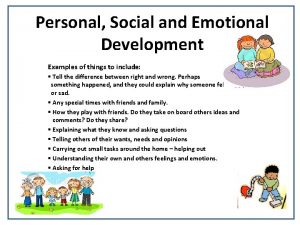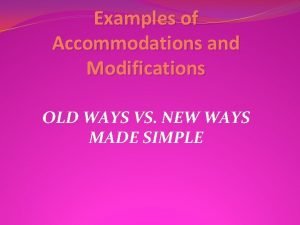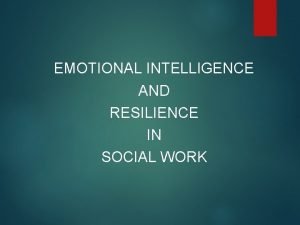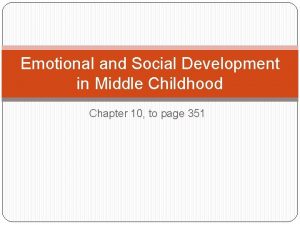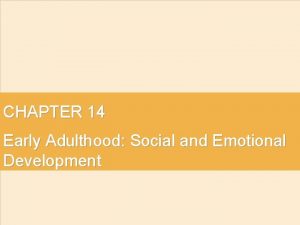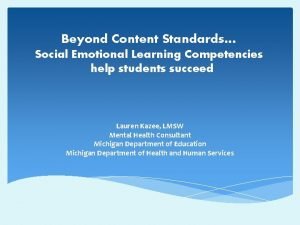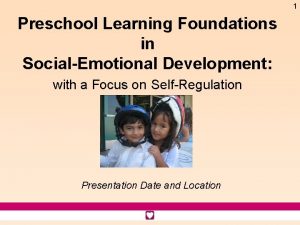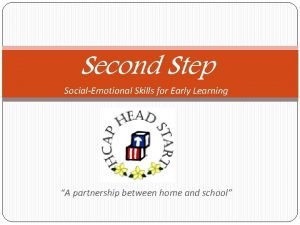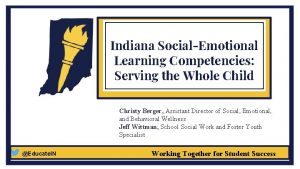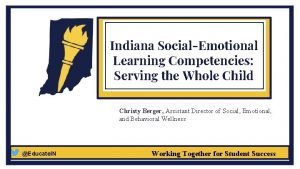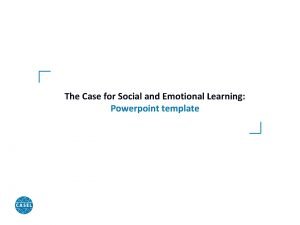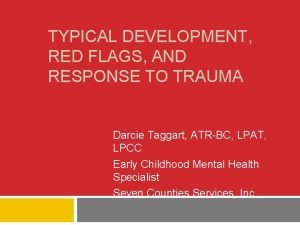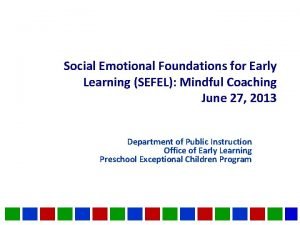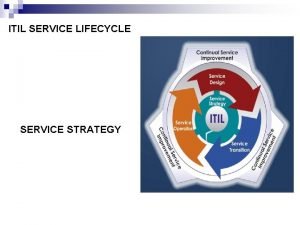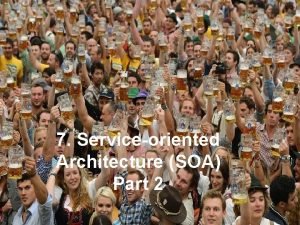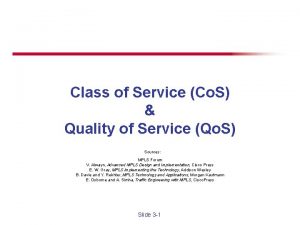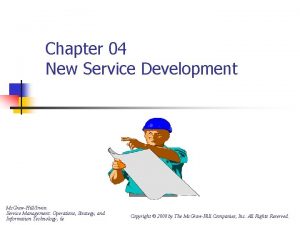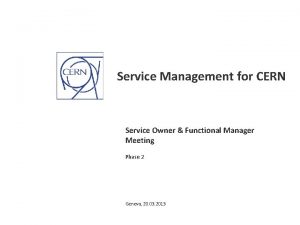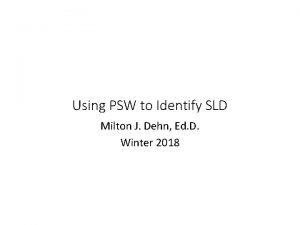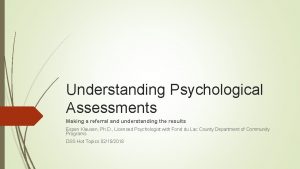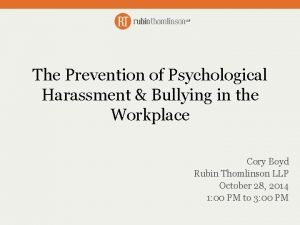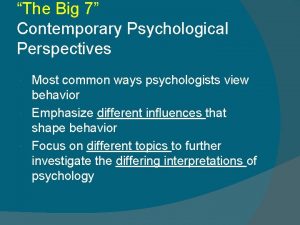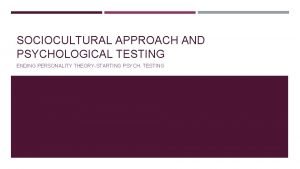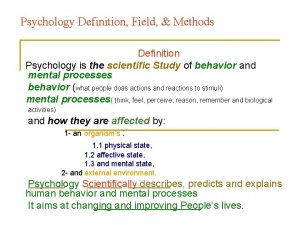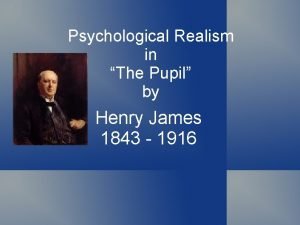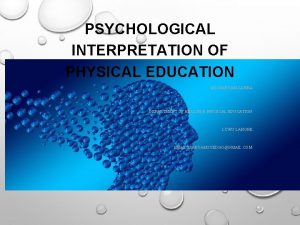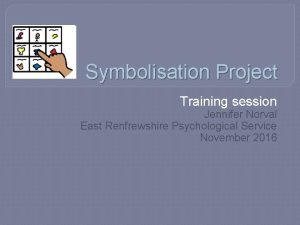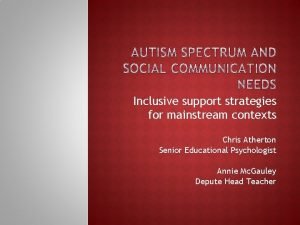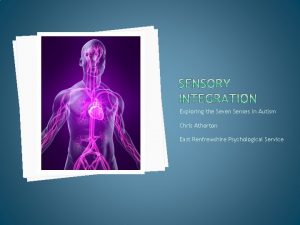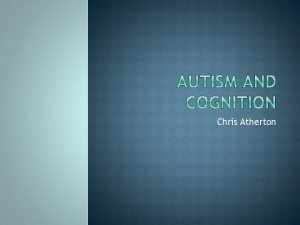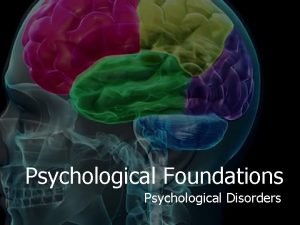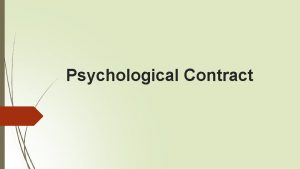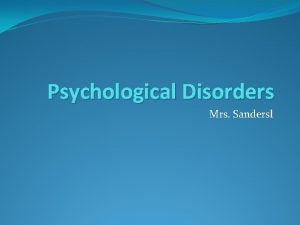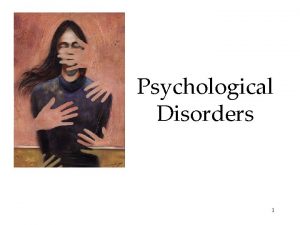Chris Atherton East Renfrewshire Psychological Service Social Emotional


















































- Slides: 50

Chris Atherton East Renfrewshire Psychological Service

� Social � Emotional � Behavioural � Structure � Routine � Predictability � Perception predict that other people are difficult to

� Social integration � Emotional awareness and control � Behavioural regulation � Empathy � Development and strengthening of emotional relationships with others

� Need for sameness and routine � Difficulties with peer relationships � Difficulties with adult relationships � Difficulties following the agenda of others � Difficulties with social interaction and understanding the intentions of others � Difficulties with social communication � Extreme emotional responses such as anxiety and anger

Heather Moran & Coventry Child and Adolescent Mental Health Service (CAMHS) Good Autism Practice, 2010

The Coventry Grid

1. 1 1. 2 1. 3 1. 4 Preference for predictability in daily life & Repetitive questions related to own intense interests Difficulties with eating Repetitive use of language Unusual relationship with treasured possessions

� Repetitive questioning re changes in routines and new experiences � Preference for ritualised caring processes (e. g. bedtimes, meals) � Ritualised greetings � � Becomes anxious if routine is removed and may seek to impose usual routine (e. g. wants same bedtime routine when away on holidays) Repetitive questioning re changes in routines and new experiences � Copes better with predictability in daily routines but usually enjoys change and celebrations � Inclined to try to repeat experiences and to interpret any repetition as routine (e. g. asks/demands repetition of following the same route to school) � Looks forward to new experiences but may not manage the emotions they provoke (e. g. may not cope with excitement or disappointment) � Distressed when a routine or ritual cannot be completed (e. g. when cannot follow the usual route because of road works) � Takes time to learn new routines � Routines tend to be imposed by adults in order to contain the child’s behaviour more easily � May cope well with new and unfamiliar experience as no previous routine has developed (e. g. horse riding; air travel) Autism Attachment

� � May limit foods eaten according to unusual criteria such as texture, shape, colour, make, situation, rather than what that food is (e. g. will eat chicken nuggets but no other chicken) May adjust eating because of literal understanding of healthy eating messages (e. g. sell- by dates, avoidance of fat) Restricted diet seems to be about maintaining sameness and the child is not easily encouraged by people the child is attached to May eat inedible substances Autism � � � � Anxious about the provision of food and may over- eat (or try to) if unlimited food is available May be unable to eat when anxious May hoard food but not eat it May be unable to eat much at a sitting May ‘crave’ foods high in carbohydrate Eating is transferable from situation to situation and the child can be persuaded by close adults Children tend to have a range of eating disorders Attachment

� � Echolalia (immediate or delayed) Repetition of ‘favoured’ words which are chosen for their sound or shape, rather than for their use in communication or emotional content Children’s repetitiveness is out of sync with their developmental stage Repetitive questioning for reassurance and predictability Autism May develop rituals for anxiety provoking situations (e. g. says same things in same order when saying goodnight or leaving for school) � Children’s repetition seems to be like that of a younger child learning and playing with language � Attachment

� � May make collections of objects, but does not seek social approval for the collection or for its care Will often be able to say where most treasured possessions are and recognise if they are moved May be unable to dispose of old toys/papers/books even though they are not used Shows a preference for old, familiar toys (or toys which are part of a series) rather than new and different toys Autism � � � May seek social approval/envy from others for possessions May not take extra care with possessions which have been given an emotional importance May be destructive with toys, exploring them and breaking them accidentally New and different toys are appreciated May lose things easily, even most treasured possessions, and may be unable to accept any responsibility for the loss May deliberately destroy emotionally significant possessions when angry Attachment

The Coventry Grid

2. 1 2. 2 2. 3 2. 4 2. 5 Poor turn taking and poor losing Unusual play with toys Poor social play Repetitive play Poor social imaginative play

� May try to impose own rules on games � May see eventually losing a game as unfair if was winning earlier in the game � Preference for playing alone or in parallel with others Autism May try to impose own rules on games so that they win � May be angry or upset about losing games and blame others or the equipment for their failure (there is a sense of fragile self esteem in the style of reaction) � Preference for playing with others who can watch them win � Attachment

� � � Plays with toys as objects rather than personifying them May spend all time organising toys and arranging in patterns (e. g. ordering by size, colour) May ‘play’ with unusual things (e. g. reading the telephone book, watching water run down the drain) for long periods from a young age Autism Uses toys to engage the attention of other children � May play games which include own experience of traumatic life events and difficult relationships � May have poor concentration on toys and be able to play alone only for very brief periods � Attachment

� Dislike and avoidance of others directing play � Harder to engage in social play with parents/carers Autism � Wants adults to provide play opportunities and/or to direct play � May prefer to play with adults (esp. carers) rather than children Attachment

� Limited range of play activities � Strong preference for the familiar and tendency to play alone on the same activity for long periods Autism � Plays repetitively with adults much as a toddler likes to play such as hide and seek, lap games � Plays out past experiences and preferred endings repeatedly (e. g. escaping from danger, saving siblings) Attachment

� � � Difficulty playing a variety of roles within games Difficulty incorporating a range of toys into the same game (e. g. using both Dr Who and Spiderman toys in a game) Preference for toys which have a mechanical rather than emotional nature (e. g. cars, trains, Lego) or which require logic and order (e. g. reviewing and organising collections of objects) or examining objects (e. g. watching spinning objects) Autism � Difficulty ending role play games � May be able to take various roles but may show a strong preference for a kind of role (e. g. always the baby, always the angry father) Attachment

The Coventry Grid

3. 1 3. 2 3. 3 3. 4 3. 5 Difficulties with social interaction More successful with adults than peers Own needs drive interactions Lacks awareness of risk and personal danger Difficulties sharing

� � Interaction is usually onesided and appears selfcentred, but can be as unaware of his/her own perspective as of others Does not often manipulate others emotionally except through angry outbursts (i. e. would rarely ingratiate self with audience), but manipulates others’ behaviour so that they do what the child feels comfortable with May perform better in less emotional situations Poor awareness of own role in interactions Autism � � � Seeks an emotionally expressive audience for interactions (e. g. seeks to provoke strong reactions in audience such as anger, sympathy, support, approval) May make persistent attempts to interact with adults or older children rather than with age peers May initiate interactions with others which allow them frequently to play the same role in relation to self (e. g. as the victim, as the bully) Attachment

� Lacks awareness of the need to share and sees no value in sharing in an activity that holds no interest for him/her � May not realise the needs of others waiting for their turn Autism Aware of the social need to share but anxious about sharing (especially food) and may refuse or hoard or hide possessions and food to avoid sharing � May take things which are important to others with awareness that this will be upsetting for the other person � Attachment

The Coventry Grid

4. 1 4. 2 4. 3 4. 4 Difficulties appreciating others’ views and thoughts Lack of appreciation of how others may see them Limited use of emotional language Problems distinguishing between fact and fiction

� Rarely refers to the views of others Autism � May be manipulative (or overly compliant) and ingratiate self with adults/children Attachment

Lacks awareness of other’s views of self, including lack of awareness of ‘visibility’ of own difficulties (e. g. may to perform gym sequence even though very poor at gym) � Does not appreciate the information parents would like to hear about successes � Autism Inclined to blame others for own mistakes � Draws attention away from own failures towards own successes � May try to shape others’ views of self by biased/exaggerated reporting � Attachment

� Rarely refers to the emotional states of self and others Autism � Hyper- vigilant with regard to particular emotions in others (e. g. anger, distress, approval) and often makes reference to these states � Poor emotional vocabulary Attachment

May not realise that cartoons, toys, animations and science fiction are not real � May not realise that fantasy play is a temporary role � May be easily influenced by fantastic claims and advertising � Lies are often easily discovered and ‘immature’ in style � Autism � � Tendency to see self as more powerful and able to overcome enemies, or as vulnerable and powerless to offer any challenge May talk repeatedly of how to overcome captors/escape from imprisonment/kill enemies even when these adversaries are obviously bigger, stronger and more powerful than the child May not be able to judge whether a threat is realistic and act as if all threats, however minor or unrealistic, need to be defended against Lies may be elaborate and also may deliberately be harmful to others’ reputations and designed to impress the audience Attachment

The Coventry Grid

5. 1 5. 2 5. 3 5. 4 5. 5 Pragmatic language problems Poor understanding of inferred jokes, sarcasm and gentle teasing Use of noise instead of speech Vocabulary Commenting

� � � � � Poor awareness of the purpose of communication Lacks awareness of needs of audience Does not repair communication breakdown Poor eye contact (may be fleeting, staring, is not synchronised with verbal communication) Proximity does not indicate intimacy or desire for contact Often does not start the conversation by addressing the person Conversation is stilted The burden of communication lies with the listener / adult Poor understanding of communicative gesture Assumes prior knowledge of listener Autism � � � Lack of attention to the needs of the listener through poor attention to communication (due to poor modelling) Eye contact affected by emotional state Proximity is an emotional signal / communication Better able to initiate a conversation May be overly sensitive to voice tone (hyper sensitive to potential emotional rejection) Attachment

� Poor understanding of idiomatic language Autism � Gentle teasing may provoke extreme distress (self esteem seems to be too fragile to cope) – internalise, assume it is about them Attachment

� Makes noises for personal pleasure (as with favourite words eg barking) Autism � Attention seeking sounds e. g. Screams, screeches / whines under stress) to signal emotional needs and wishes Attachment

� May have word finding problems � Often has unusually good vocabulary (for age or cognitive ability, or within specific interest areas) � Less use of vocabulary related to emotions Autism � Often poor vocabulary range for age and ability � May use more emotive vocabulary (to get needs met) Attachment

� Provides detail in pedantic fashion and gives excessive information Autism � Reduced amount of commenting behaviour Attachment

The Coventry Grid

6. 1 6. 2 6. 3 Difficulties managing own emotions and appreciating how others manage theirs Unusual mood patterns Inclined to panic

� � � Extremes of emotion may provoke anxiety and repetitive questioning and behaviour Does not easily learn management of emotions from modelling (also likely to need an explanation) Poor recognition of own and other’s emotions Lack of emotional control because of lack of awareness and emotional understanding Different contexts and settings trigger outbursts Autism � � Difficulties coping with extremes of emotions and recovering from them (e. g. Excitement, fear, anger, sadness) May provoke extreme emotional reactions in other which tend to cast others in roles which are familiar from their own past experience of less healthy relationships May be able to learn more easily from non-verbal example than from talking Shows emotional displays to people child does not know (indiscriminate) and tend to carry on longer (e. g. temper tantrums occur anywhere and at any time) Attachment

� Sudden mood changes in response to perceived injustice Autism � Sudden mood changes in response to internal states and perceived demands Attachment

� Panics about change in routines and rituals and about unexpected experiences Autism � Panic related to no having perceived needs met (especially food, drink, comfort, attention) � Fixated on certain events � Recall may be confused � Selective recall Attachment


7. 1 7. 2 Unusual memory Difficulties with concept of time – limited intuitive sense of time

� Poor working memory unless well motivated � Very unusual long term memory with recall of excessive detail � Difficulties in planning and sequencing actions Autism � Fixated on certain events � Recall may be confused � Selective recall Attachment

� Rigid reliance on using precise times (e. g. Uses watch an unable to guess time) � Waiting irritates child because it affects routine and because unable to judge time or mark time Autism � Time has emotional significance (e. g. Waiting a long time for dinner is quickly associated with feelings of emotional neglect and rejection) Attachment

The Coventry Grid

8. 1 Difficulty integrating information from senses (e. g. Lack of awareness of heat, cold, pain, thirst, hunger, need to urinate, defecate. ) 8. 2 Unusual physical proximity

� May be passive or quiet in acceptance of discomfort or may be distressed but does not communicate the source of distress. � May be hyper or hypo sensitive to some sensations Autism � Physical discomfort may be accompanied by a strong emotional reaction towards carer (e. g. Anger and blame of carer for the discomfort) Attachment

� Physical distance is unrelated to intimacy Autism � Shows awareness that physical distance is related to emotional reactions (e. g. Increases distance to signify rejection, seeks excessive closeness when anticipating separation) Attachment

Domain Assessment Lack of flexibility of thought and behaviour Strongly suggestive of autism spectrum condition Play Strongly suggestive of attachment difficulties Poor social interaction ? Mind reading ? Communication ? Emotional Regulation ? Problems with executive function ? Sensory integration problems ? Formulation Mixed attachment and autism spectrum presentation

� ‘. . . both present difficulty with flexible thinking and behaviour. Their behaviour can be demanding and ritualistic, with a strong element of control over other people and their environment. The different ‘flavour’ seems to be about personality style, a strongly cognitive approach to the world in the autism spectrum, and a strongly emotional approach in attachment problems. The need for predictability in attachment disorder suggests that the child is trying to have their emotional needs for security and identity met. In autism, the emphasis seems to be on trying to make the world fit with the child’s preferences. ’ (Heather Moran, Coventry Grid, 2010)
 East renfrewshire council planning
East renfrewshire council planning Winds that blow over short distances are called
Winds that blow over short distances are called Laissez faire theory
Laissez faire theory East is east and west is west
East is east and west is west Social thinking and social influence in psychology
Social thinking and social influence in psychology Social thinking social influence social relations
Social thinking social influence social relations Social emotional assets and resilience scales pdf
Social emotional assets and resilience scales pdf Social emotional needs of ell students
Social emotional needs of ell students Personal, social and emotional development examples
Personal, social and emotional development examples Social emotional present level of performance examples
Social emotional present level of performance examples Generativity stage
Generativity stage Emotional resilience in social work
Emotional resilience in social work Social and emotional development in middle childhood
Social and emotional development in middle childhood Social development for middle adulthood
Social development for middle adulthood Social development in early adulthood
Social development in early adulthood Social emotional learning standards michigan
Social emotional learning standards michigan Preschool learning foundations social emotional
Preschool learning foundations social emotional Second step social emotional skills for early learning
Second step social emotional skills for early learning Social emotional learning standards nj
Social emotional learning standards nj Indiana social emotional learning competencies
Indiana social emotional learning competencies Social emotional learning standards indiana
Social emotional learning standards indiana Emotional health and wellbeing framework
Emotional health and wellbeing framework Washington state social emotional learning standards
Washington state social emotional learning standards Social emotional learning powerpoint
Social emotional learning powerpoint Megg thompson match game
Megg thompson match game Sefel training
Sefel training Social and emotional development in late adulthood
Social and emotional development in late adulthood East ayrshire health and social care partnership
East ayrshire health and social care partnership East lothian health and social care partnership
East lothian health and social care partnership Itil service lifecycle model
Itil service lifecycle model Which of the stages of service lifecycle
Which of the stages of service lifecycle Itil 7 step improvement process
Itil 7 step improvement process Factors that influence desired service expectations
Factors that influence desired service expectations Evolution of soa
Evolution of soa Class of service vs quality of service
Class of service vs quality of service New service development in service marketing
New service development in service marketing Service owner vs service manager
Service owner vs service manager Service improvement plan for service desk
Service improvement plan for service desk Adp etime portal
Adp etime portal Mn sld regression table
Mn sld regression table Examples of referral questions for psychological testing
Examples of referral questions for psychological testing Very superior intelligence
Very superior intelligence Marsh et al
Marsh et al Linear view of communication
Linear view of communication Sociocultural perspective
Sociocultural perspective Psychological testing examples
Psychological testing examples Chapter 18 psychological disorders
Chapter 18 psychological disorders Field methods in psychology
Field methods in psychology Definition of psychological thriller
Definition of psychological thriller The pupil henry james
The pupil henry james Psychological interpretation of physical education
Psychological interpretation of physical education
